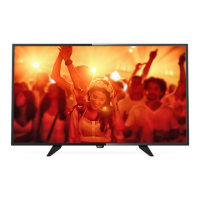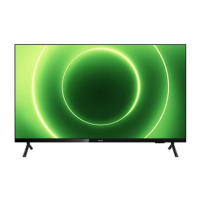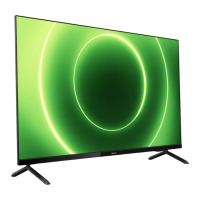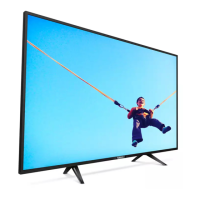Do you have a question about the Philips 32PHH4100 and is the answer not in the manual?
Functionality for pausing and recording broadcasts.
Control connected devices with the TV remote using HDMI CEC.
Emphasizes reading safety instructions before use.
Instructions for attaching the TV stand or wall mount.
Guidance on optimal TV placement for viewing.
Instructions for connecting and handling the power cable.
How to connect the antenna cable for signal reception.
Advice on using quality cables for best picture and sound.
Explains HDMI CEC for device communication and control.
How to connect devices with DVI output to HDMI input.
Information on HDCP for content protection.
Using HDMI ARC for audio return channel functionality.
Connection details for SCART interface for video and audio.
Connecting audio out via optical cable for high-quality sound.
Configuration steps for EasyLink functionality.
Using a CAM module for conditional access to premium channels.
Connecting a set-top box for digital TV reception.
Connecting a satellite receiver for TV channels.
Connecting a Home Theatre System for enhanced audio.
Setting a delay for audio output to match video.
Automatic synchronization of audio and video.
Manually adjusting audio delay for synchronization.
Compensating for sound processing time with TV offset.
Setting audio output format for multichannel sound.
Adjusting volume levels between TV and audio system.
Troubleshooting sound issues with Home Theatre Systems.
Connecting a Blu-ray Disc player via HDMI.
Connecting a DVD player via HDMI or SCART.
Connecting a game console via HDMI for optimal settings.
Requirements and usage for USB Hard Drives for pause/record.
Viewing photos, music, and videos from a USB flash drive.
Connecting a camcorder via HDMI.
Connecting a computer to use the TV as a monitor.
Connecting and adjusting volume for headphones.
How to switch the TV on and put it in standby mode.
Turning the TV off and disconnecting power.
Detailed explanation of the remote control buttons and functions.
Location and function of the TV's infrared sensor.
Installing and replacing batteries in the remote control.
How to clean the remote control safely.
How to tune into TV channels and navigate the channel list.
Viewing, renaming, and locking channels.
Setting parental controls based on age ratings.
Adjusting the picture aspect ratio to fit the screen.
Accessing and navigating Teletext pages.
Options for Teletext display and language settings.
Managing subtitles for digital and analogue channels.
Selecting preferred audio languages for programs.
Changing the TV's menu and display language.
Automatic and manual updates for channel lists.
Finding and managing newly added channels.
Reinstalling channels without affecting other settings.
Performing a complete reinstallation of the TV.
Resetting the TV to its original factory settings.
Using USB to copy and upload channel lists between TVs.
Information on DVB-T and DVB-C reception.
Installing DVB-C channels with specific provider values.
Accessing and configuring DVB settings.
Entering network frequency and ID for cable providers.
Selecting scan methods for finding channels.
Viewing current and scheduled TV programmes.
How to access and close the TV guide.
Switching to programs and viewing details from the guide.
Finding programs by genre and scheduling recordings.
Displaying connected devices and switching between them.
Switching on connected devices from TV standby mode.
Operating connected devices with the TV remote via HDMI CEC.
Setting the TV to switch to standby after a preset time.
Correcting the TV clock time and daylight saving settings.
Deactivating the automatic TV power-off feature.
Viewing media files from a USB device.
Navigating file types (Picture, Music, Movie) in the USB browser.
Options for viewing photos, including slideshow settings.
Options for playing music files, including repeat and shuffle.
Options for playing video files, including subtitles and audio language.
Pausing and resuming digital TV broadcasts.
Replaying the last 10 seconds of a broadcast.
Using the progress bar for navigating paused broadcasts.
Prerequisites for recording TV programs.
Recording the current program or scheduling future recordings.
How to play back recorded programs.
Selecting and adjusting preset picture styles.
Adjusting backlight, colour, sharpness, and noise reduction.
Troubleshooting the Vivid picture style setting.
Reducing digital artefacts in the picture.
Advanced adjustments for Gamma, Tint, and Video Contrast.
Optimizing picture settings for gaming or computer use.
Adjusting the picture aspect ratio to fit the screen.
Enlarging picture to hide distorted edges.
Selecting and adjusting preset sound styles.
Adjusting the low and high tones in the sound.
Setting the sound effect for TV speakers.
Adjusting the volume for connected headphones.
Advanced audio settings like auto volume levelling.
Configuring TV speaker output and control.
Sending TV sound to connected audio devices.
Selecting Ambilight modes (Dynamic/Static) and colours.
Adjusting the brightness level of Ambilight.
Adjusting the saturation level of Ambilight.
Setting the speed of Ambilight response to screen images.
Advanced Ambilight settings like wall colour.
Information on energy saving features and environmental considerations.
Checking power consumption and settings.
Information on the product's energy efficiency class.
Disposal instructions for old products and batteries.
Technical details on TV reception capabilities.
Screen size, resolution, and computer input resolutions.
Physical dimensions and weights of various TV models.
List of rear and side connectivity ports for specific models.
Sound specifications including output power and enhancements.
Supported multimedia file formats and USB connections.
Instructions for updating TV software from a USB device.
Checking the current TV software version.
Information about open source software used in the TV.
Details on open source license statements and terms.
Details on various software libraries like SQLite, libpng, OpenSSL, etc.
Solutions for channel detection and list problems.
Troubleshooting power, sound, and remote control issues.
Troubleshooting picture and display problems.
Troubleshooting sound issues.
Troubleshooting HDMI and DVI connections.
Troubleshooting EasyLink and USB media playback.
Accessing on-screen help, online support, and registration.
Contacting customer support for service or repair.
Important safety instructions for using the TV.
Instructions for securing the TV to prevent tipping.
Precautions against electrical hazards and fire.
Safety measures for lifting, carrying, and mounting the TV.
Handling lightning storms, hearing damage, temperature, and humidity.
Guidelines for cleaning and maintaining the TV screen.
Legal terms and conditions for using the product.
Information on HDMI and Dolby copyrights and licenses.
Copyright information for MHEG software.
Trademark information for Kensington and other brands.
Functionality for pausing and recording broadcasts.
Control connected devices with the TV remote using HDMI CEC.
Emphasizes reading safety instructions before use.
Instructions for attaching the TV stand or wall mount.
Guidance on optimal TV placement for viewing.
Instructions for connecting and handling the power cable.
How to connect the antenna cable for signal reception.
Advice on using quality cables for best picture and sound.
Explains HDMI CEC for device communication and control.
How to connect devices with DVI output to HDMI input.
Information on HDCP for content protection.
Using HDMI ARC for audio return channel functionality.
Connection details for SCART interface for video and audio.
Connecting audio out via optical cable for high-quality sound.
Configuration steps for EasyLink functionality.
Using a CAM module for conditional access to premium channels.
Connecting a set-top box for digital TV reception.
Connecting a satellite receiver for TV channels.
Connecting a Home Theatre System for enhanced audio.
Setting a delay for audio output to match video.
Automatic synchronization of audio and video.
Manually adjusting audio delay for synchronization.
Compensating for sound processing time with TV offset.
Setting audio output format for multichannel sound.
Adjusting volume levels between TV and audio system.
Troubleshooting sound issues with Home Theatre Systems.
Connecting a Blu-ray Disc player via HDMI.
Connecting a DVD player via HDMI or SCART.
Connecting a game console via HDMI for optimal settings.
Requirements and usage for USB Hard Drives for pause/record.
Viewing photos, music, and videos from a USB flash drive.
Connecting a camcorder via HDMI.
Connecting a computer to use the TV as a monitor.
Connecting and adjusting volume for headphones.
How to switch the TV on and put it in standby mode.
Turning the TV off and disconnecting power.
Detailed explanation of the remote control buttons and functions.
Location and function of the TV's infrared sensor.
Installing and replacing batteries in the remote control.
How to clean the remote control safely.
How to tune into TV channels and navigate the channel list.
Viewing, renaming, and locking channels.
Setting parental controls based on age ratings.
Adjusting the picture aspect ratio to fit the screen.
Accessing and navigating Teletext pages.
Options for Teletext display and language settings.
Managing subtitles for digital and analogue channels.
Selecting preferred audio languages for programs.
Changing the TV's menu and display language.
Automatic and manual updates for channel lists.
Finding and managing newly added channels.
Reinstalling channels without affecting other settings.
Performing a complete reinstallation of the TV.
Resetting the TV to its original factory settings.
Using USB to copy and upload channel lists between TVs.
Information on DVB-T and DVB-C reception.
Installing DVB-C channels with specific provider values.
Accessing and configuring DVB settings.
Entering network frequency and ID for cable providers.
Selecting scan methods for finding channels.
Viewing current and scheduled TV programmes.
How to access and close the TV guide.
Switching to programs and viewing details from the guide.
Finding programs by genre and scheduling recordings.
Displaying connected devices and switching between them.
Switching on connected devices from TV standby mode.
Operating connected devices with the TV remote via HDMI CEC.
Setting the TV to switch to standby after a preset time.
Correcting the TV clock time and daylight saving settings.
Deactivating the automatic TV power-off feature.
Viewing media files from a USB device.
Navigating file types (Picture, Music, Movie) in the USB browser.
Options for viewing photos, including slideshow settings.
Options for playing music files, including repeat and shuffle.
Options for playing video files, including subtitles and audio language.
Pausing and resuming digital TV broadcasts.
Replaying the last 10 seconds of a broadcast.
Using the progress bar for navigating paused broadcasts.
Prerequisites for recording TV programs.
Recording the current program or scheduling future recordings.
How to play back recorded programs.
Selecting and adjusting preset picture styles.
Adjusting backlight, colour, sharpness, and noise reduction.
Troubleshooting the Vivid picture style setting.
Reducing digital artefacts in the picture.
Advanced adjustments for Gamma, Tint, and Video Contrast.
Optimizing picture settings for gaming or computer use.
Adjusting the picture aspect ratio to fit the screen.
Enlarging picture to hide distorted edges.
Selecting and adjusting preset sound styles.
Adjusting the low and high tones in the sound.
Setting the sound effect for TV speakers.
Adjusting the volume for connected headphones.
Advanced audio settings like auto volume levelling.
Configuring TV speaker output and control.
Sending TV sound to connected audio devices.
Selecting Ambilight modes (Dynamic/Static) and colours.
Adjusting the brightness level of Ambilight.
Adjusting the saturation level of Ambilight.
Setting the speed of Ambilight response to screen images.
Advanced Ambilight settings like wall colour.
Information on energy saving features and environmental considerations.
Checking power consumption and settings.
Information on the product's energy efficiency class.
Disposal instructions for old products and batteries.
Technical details on TV reception capabilities.
Screen size, resolution, and computer input resolutions.
Physical dimensions and weights of various TV models.
List of rear and side connectivity ports for specific models.
Sound specifications including output power and enhancements.
Supported multimedia file formats and USB connections.
Instructions for updating TV software from a USB device.
Checking the current TV software version.
Information about open source software used in the TV.
Details on open source license statements and terms.
Details on various software libraries like SQLite, libpng, OpenSSL, etc.
Solutions for channel detection and list problems.
Troubleshooting power, sound, and remote control issues.
Troubleshooting picture and display problems.
Troubleshooting sound issues.
Troubleshooting HDMI and DVI connections.
Troubleshooting EasyLink and USB media playback.
Accessing on-screen help, online support, and registration.
Contacting customer support for service or repair.
Important safety instructions for using the TV.
Instructions for securing the TV to prevent tipping.
Precautions against electrical hazards and fire.
Safety measures for lifting, carrying, and mounting the TV.
Handling lightning storms, hearing damage, temperature, and humidity.
Guidelines for cleaning and maintaining the TV screen.
Legal terms and conditions for using the product.
Information on HDMI and Dolby copyrights and licenses.
Copyright information for MHEG software.
Trademark information for Kensington and other brands.
| Screen shape | Flat |
|---|---|
| Response time | - ms |
| Display diagonal | 32 \ |
| Display brightness | 200 cd/m² |
| Display resolution | 1366 x 768 pixels |
| Native aspect ratio | 16:9 |
| Native refresh rate | 60 Hz |
| LED backlighting type | - |
| Screen format adjustments | 4:3, 16:9 |
| Motion interpolation technology | PMR (Perfect Motion Rate) 100 Hz |
| 3D | No |
| Annual energy consumption | 44 kWh |
| Tuner type | Analog & digital |
| Analog signal format system | NTSC, PAL, SECAM |
| Digital signal format system | DVB-C, DVB-T |
| RMS rated power | 16 W |
| DVI-D ports quantity | 0 |
| USB 2.0 ports quantity | 1 |
| Consumer Electronics Control (CEC) | EasyLink |
| Audio formats supported | AAC, MP3, WAV, WMA |
| Image formats supported | GIF, JPG, PNG |
| Video formats supported | AVC, AVI, H.264, MKV, MPEG1, MPEG2, MPEG4, VC-1, WMV9 |
| Product color | Black |
| Panel mounting interface | 100 x 100 mm |
| AC input voltage | 220 - 240 V |
| AC input frequency | 50 - 60 Hz |
| Power consumption (standby) | 0.3 W |
| Power consumption (typical) | 30 W |
| Package depth | 131 mm |
| Package width | 850 mm |
| Package height | 510 mm |
| Package weight | 7300 g |
| Cables included | AC |
| Depth (with stand) | 181 mm |
|---|---|
| Height (with stand) | 464 mm |
| Weight (with stand) | 5100 g |
| Depth (without stand) | 77 mm |
| Width (without stand) | 726 mm |
| Height (without stand) | 425 mm |
| Weight (without stand) | 4800 g |











